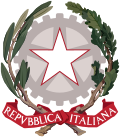| Civil and Military Order of the Roman Eagle | |
|---|---|
 The insignia of Order of the Roman Eagle | |
| Presented by | the |
| Status | abolished |
| Established | 14 March 1942 |
| Ribbon of the order | |
The Fascist Civil and Military Order of the Roman Eagle founded in 1942 with civil and military divisions, [1] was abolished in Italy in 1944; [2] although it continued to be awarded by Benito Mussolini in the short-lived Italian Social Republic until 1945. [3] A self-styled order of the same name was founded by Romano Mussolini, fourth and youngest son of Benito Mussolini, in 1997. [4]
